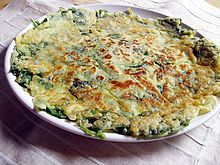Korean pancake

Banga-buchimgae (Korean mint pancake)
|
|
| Alternative names | Korean pancake, buchim, jijim, jijimgae, jijimi, jeonbyeong |
|---|---|
| Course | Appetizer, banchan, anju |
| Place of origin | Korea |
| Associated national cuisine | Korean cuisine |
| Main ingredients | Fish, meat, poultry, seafood, vegetable, flour, eggs |
| |
|
| Korean name | |
| Hangul | 부침개 |
|---|---|
| Hanja | n/a |
| Revised Romanization | buchimgae |
| McCune–Reischauer | puch'imgae |
| IPA | [pu.tɕʰim.ɡɛ̝] |
Buchimgae (부침개), or Korean pancake, refers broadly to any type of pan-fried ingredients soaked in egg or a batter mixed with other ingredients. More specifically, it is a dish made by pan-frying a thick batter mixed with egg and other ingredients until a thin flat pancake is formed.
Jeon is a dish made by frying a mixture of seasoned sliced or minced fish, meat, and vegetables in oil. Ingredients are coated with wheat flour prior to pan-frying the mixture in oil.
Bindae-tteok is a dish made by grinding soaked mung beans, adding vegetables and meat, and pan-frying until the mixture has attained a round and flat shape. No flour or egg is added in bindae-tteok.
Jangtteok is a dish made by adding wheat flour to gochujang or doenjang (soybean paste). Vegetables, such as Java waterdropworts or scallions, are added and the mixture pan-fried in oil into a thin flat pancake.
various buchimgae
kimchi-buchimgae (kimchi pancake)
memil-buchimgae (buckwheat pancake)
bindae-tteok (mung bean pancake)
buchimgae-type pajeon (scallion pancake)
...
Wikipedia
